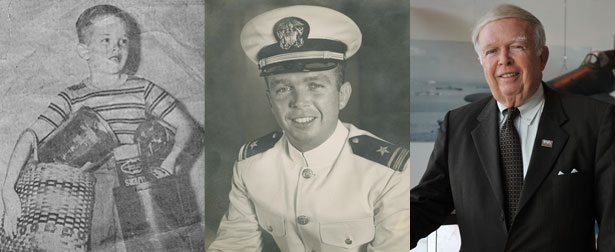Donor Spotlight- Frank B. Stewart, Jr.
The National WWII Museum is proud to highlight capstone donor Frank B. Stewart, Jr., a dedicated supporter and advocate of the Museum since before its inception. Born and raised in New Orleans, Mr. Stewart saw the need early on for the city to become home to a “venue to teach present generations and generations to come the price of peace and the consequence of war.” In addition to his capstone gift, he has served on the Museum’s Board of Trustees, and has generously supported ongoing exhibit planning efforts. His lifetime of service and spirit of giving are illustrated in the above photographs.
Stewart remembers sitting at school while hearing President Roosevelt’s famous address to Congress and to the nation on December 8, 1941, the day after the surprise Japanese attack at Pearl Harbor. He remembers listening and asking questions such as “what does the word infamy mean?” He and his schoolmates were “scared to death” of what was to come, rushing to the basement and huddling together with a fear of the unknown.
He felt inspired to take action. Even children had a job to do. Shown in the photo to the far left above, an 8-year-old Stewart had collected several tin cans to take to Audubon Grammar School on Broadway when the State Waste Fats Campaign began. Mr. Stewart embraced the spirit that everyone old enough for school was expected to collect items for the war effort. He remembers collecting foil, gum wrappers, cans of lard, hangers, and newspapers while pulling along a wagon that held his bounty. As a young student he collected newspapers every weekend for five years, determined to make his school “first in the nation.”
Stewart’s dad was a WWII air raid warden, responsible for enforcing regulations during an air attack. He remembers having to turn all the lights off and pull down the shades as precautions. Strange as it may seem today, there were constant fears that bombs would be dropped at any time. His mother made bandages two to three days a week as part of a wives group organized by the Red Cross, and he recalls slipping into Higgins Industries shipyards to watch with fascination the production lines where military landing craft were manufactured.
After the war, as Stewart became an adult, he remained dedicated to public service and to the spirit of citizenship. He served in the US Navy on mine sweepers patrolling the coasts of Florida and Cuba in 1950s. He was commissioned in the year 1957, and was promoted to lieutenant junior grade at the age of 25. A photograph taken around the time of this promotion is shown above. A graduate of Jesuit High School and Tulane University in New Orleans, Stewart has always given priority to discipline, which he defines as “the ability to make yourself do what you have to do or should do, rather than what you want to do.” He believes this principle is the foundation for success in life and was the key to Allied victory in World War II.
Stewart first became involved with the Museum through a meeting with Stephen Ambrose and Gordon “Nick” Mueller, both then serving as University of New Orleans history professors. Mr. Stewart said he will never forget that meeting. He recalls being deeply impressed with Stephen Ambrose; he had watched his lectures and was familiar with his books. When they explained their plan to build a museum to honor the veterans of WWII and preserve the story for future generations, and that it “would not happen unless a commitment was made,” Stewart recognized the importance of the idea and provided a critical early gift. As a result of such support, The National D-Day Museum concept came to life and the institution opened to the public on June 6, 2000.
Stewart still considers that gift as one of the more gratifying achievements of his life. He feels philanthropy is important because “life has given me everything. I have got to give back because of what life has given to me.” The lesson he most wants to share with others – through the Museum and its programs – is how America won the war after trailing badly in its defense preparation, and how citizens can succeed at anything through discipline and hard work. He feels it is important to share what he has learned in his lifetime. His philosophy: “I am a relay runner in life. I have obtained the baton of knowledge from men that have come before me, and I have to use it and pass it on to the next runner.”
He hopes to be remembered for “having done the right thing for the right reason.”
We extend our sincere thanks to Mr. Frank B. Stewart, Jr. His leadership gift continues to allow us to fulfill our mission of telling the story of the war that changed the world – why it was fought, how it was won, and what it means today. The National WWII Museum would not be where it is today without his generous support.
Post by Donor Relations Manager Lauren Bevis
- Posted :
- Post Category :
- Tags :
- Follow responses to this entry through the RSS 2.0 feed. You can skip to the end and leave a response. Pinging is currently not allowed.





Leave a Reply